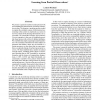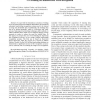20833 search results - page 129 / 4167 » Hidden process models |
IJCAI
2007
14 years 11 months ago
2007
We present a general machine learning framework for modelling the phenomenon of missing information in data. We propose a masking process model to capture the stochastic nature of...
NN
2002
Springer
14 years 9 months ago
2002
Springer
Acetylcholine (ACh) plays an important role in a wide variety of cognitive tasks, such as perception, selective attention, associative learning, and memory. Extensive experimental...
100
click to vote
ICDAR
2011
IEEE
13 years 9 months ago
2011
IEEE
—To cope with the tremendous variations of writing styles encountered between different individuals, unconstrained automatic handwriting recognition systems need to be trained on...
BC
1998
14 years 9 months ago
1998
Saccadic averaging is the phenomenon that two simultaneously presented retinal inputs result in a saccade with an endpoint located on an intermediate position between the two stimu...
JMLR
2010
14 years 4 months ago
2010
We show how a preselection of hidden variables can be used to efficiently train generative models with binary hidden variables. The approach is based on Expectation Maximization (...


